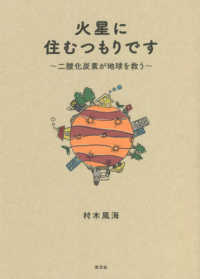- ホーム
- > 洋書
- > 英文書
- > History / World
Full Description
Anyone making a study of the causes that led to the fall of the Chinese mainland into Communist hands will have to examine the long struggles between the two major rival parties in China, the Nationalists or the Kuomintang and the Chinese Communists. As the author once took a personal part in those struggles, he has assumed the task of giving an account of the facts as known to him. Some of the intricate events recorded in the following pages may be little known to the outside world or have not yet been revealed by others. What he has put down here has been carefully checked by him and is all backed up by firsthand sources. For example, on the eve of the March 19, 1926 Chungshan gunboat incident at Canton, an incident in which the Communists had plotted to kidnap General Chiang Kai-shek, then Commandant of the Whampoa Military Academy, someone had asked the General himself in person whether he was going back to Whampoa that day. Three telephone calls were made asking this question. In making a report of the incident after it was over, General Chiang did not identify who the individual was who was so persistent in ascertaining the General's movements on that momentous day, nor did he ever breathe a word of it even to his closest aides. Up to now few people know for sure who the person might have been.
Contents
I. Dr. Sun's Policy of Aligning with Soviet Russia and Admitting Chinese Communists to Kuomintang Membership.- II. Why Did the Third International Order Chinese Reds to Become Members of the Kuomintang?.- III. The Kuomintang after Admitting Chinese Reds to its Membership.- IV. Purging of the Party and Stoppage of Kuomintang Communist Cooperation.- V. Armed Uprisings and the Trek to Yenan.- VI. Direct Talks Between the Kuomintang and the Communists.- VII. American Mediation and the Political Consultative Conference.- VIII. Peace Talks During the Acting-Presidency of Li Tsung-Jen`.






